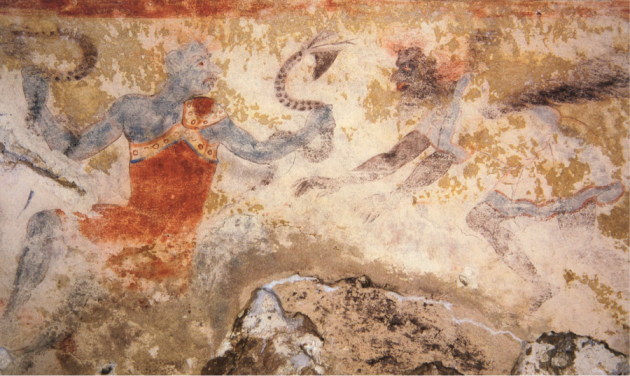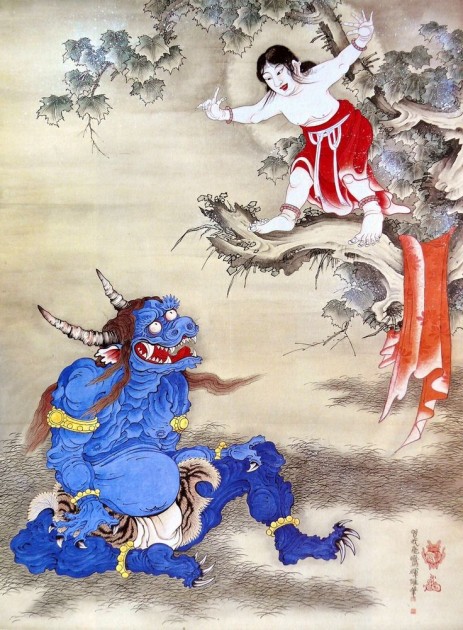Wednesday, November 11th, 2015
Blue-Skinned Demons, Monsters, and Gods

Detail of Blue demon and snakes with another demon, Tomb of the Blue Demons, Necropolis of Tarquinia, Lazio, Italy. 5th century BC, Etruscan
Last week my students and I were discussing the blue demons that are found in some Etruscan tombs. We were exploring two different reasons which might explain why these demons have blue skin. One theory is that the blue skin is a depiction of rotting human flesh: these demons are embodiments of death.1 A different, yet also related theory, is that the blue color relates to the skin discoloration which occurs when someone is bit by a deadly, poisonous snake, specifically an adder.2
During this discussion, two different students mentioned that the blue skin reminded them of demons and religious figures found in other cultures. I never thought too deeply about how blue skin appears in different cultures across the world, and I thought I’d make a little compilation of a few noteworthy examples.

Soga Shôhaku, (1730-1781), Sessen Doji (Sessendoujizu) scene with a blue oni, detail from a hanging scroll. Ink on silk, about 1770s, Keishouji Temple.
The oni is an ogre or troll, and it is a common figure in Japanese folklore. They have distinctive long horns, which makes them appear to be a combination of both beasts and humans. Onis most commonly appear with blue, red or green skin, and they are often clad in tiger skin. One particular representation of the oni that I like is from the 18th century (shown above), in a painting by Soga Shôhaku. Here, an oni is used to depict a demon from the Sessen Doji tale.
In thinking about the various colors which can be used for the oni’s skin, I wonder if color is supposed to suggest that the figure is inhuman. From what I can tell, the color of the skin doesn’t matter (since red, blue, and green are all used), but all of the colors are very different from how human skin actually appears. To me, the blue skin of the no suggests that the figure is otherworldly, which by extension makes the figure seem more threatening to me. The creators of the film Avatar used blue skin for the same reason; they played with modern associations regarding skin color and race to make sure that moviegoers could perceive these figures not only as aliens, but as Others.
Krishna Fluting for the Gopis, page from an illustrated Dashavatara series, ca. 1730. Opaque watercolor and gold on paper, 10 1/4 x 8 in.
In some cases, though, the color blue has much more significance than to draw a visual distinction of difference between a the figure-in-question and a human audience. Such is the case with Hindu art, in which more than one blue-skinned figure appears. Perhaps the most common figure who can appear with blue skin is Vishnu (who can also appear with blue skin as Krishna, considered by many to be an avatar of Vishnu). Some claim that the blue skin in this religious context has positive connotations, suggesting the sky and the limitlessness of the sky and universe. Blue also references life and the forces of life, since bodies of water can appear blue. Finally, others assert that the color blue in Hinduism is used to describe manliness, bravery, a stable mind and a depth of character. How curious that the color blue can suggest a depth of character in Hinduism, whereas the blue color in Japanese folklore seems to suggest an inhuman creature (which perhaps implies a lack of character or positive human feeling, right?)!

Vishnu Vishvarupa, India, Rajasthan, Jaipur, ca. 1800-20 Opaque watercolor and gold on paper, 38.5 x 28cm Victoria and Albert Museum, London
I know of a few other instances where blue-skinned figures appear, too. In Balinese culture the traditional gods can appear with blue skin. A traditional Balinese monster, the oguh-oguh, also can appear with blue skin (although various colors are used to depict the oguh-oguh, so the color doesn’t seem to be a qualifying feature).
Do you know of other cultural instances in which blue-skinned figures occur in art? If you know of other cultural and/or symbolic associations with blue skin too, please share!
1 How Art Made the World: To Death and Back, directed by Nick Murphy. London: BBC, 2005. Available online: https://youtu.be/ekR_kPJVTtA?list=PLE84B4973D9F49E44
2 Kristin Lee Hostetler, “Serpent Iconography,” in Etruscan Studies 10, no. 16 (2007): 203.
Once on a trip to Venice I visited Torcello, which is one of the outlying islands in the Venetian Lagoon. Its cathedral has the earliest known image of the devil as part of the Last Judgement, and he was definitely blue skinned. IIRC, Dante visited Torcello before writing the Divine Comedy—but I may be mistaken.
I have a picture of a demon with blue skin and red lips. I have taken more then one picture of this thing. Im very curious to find info on what this thing may be. Any info would be great thank you
Great point about the blue skin discoloration being an effect of snake bite. You never mentioned that all of these hindu characters are depicted with lots of snakes crawling on them tho.
@Ryan pavelko, I’d love to see your pics. I’d like to find out what blue skinned creatures are of short stature, have large eyes, have large pointed ears (similar to those of elves etc), and have lots of sharp teeth. They can have hair or no hair. I think either they are some sort of devil or elves.
Osiris, the Ancient Egyptian god, also has blue skin. It is interesting that so many unrelated cultures have blue skinned deities.